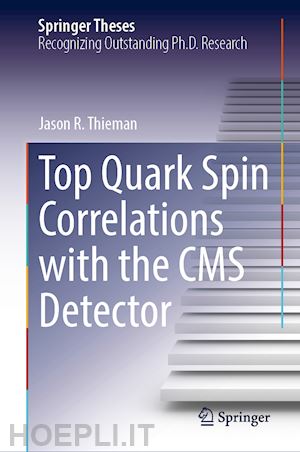
Questo prodotto usufruisce delle SPEDIZIONI GRATIS
selezionando l'opzione Corriere Veloce in fase di ordine.
Pagabile anche con Carta della cultura giovani e del merito, 18App Bonus Cultura e Carta del Docente
The differential top quark precision measurements of polarizations and spin correlations presented in this dissertation may potentially lead to breakthroughs in several key areas: observing quantum entanglement and Bell's Inequality violations in a hadronic system, discovering toponium, illuminating supersymmetry, interpreting field theories beyond the Standard Model, and advancing the understanding of electroweak vacuum stability.
Additionally, this thesis provides a significantly improved understanding of CMS detector lepton trigger efficiencies, which has greatly enhanced the search for Lorentz invariance violation in top quark events, boosting the sensitivity by greater than a factor of 100.
Finally, the thesis includes TCAD simulations that explore the feasibility of using the initial transient induced current, as described by the Ramo-Shockley Theorem, to achieve the picosecond timing precision in silicon pixel detectors needed for four-dimensional tracking.
1 Motivation and Theoretical Overview.- 2 The Compact Muon Experiment at the Large Hadron Collider.- 3 Top Quark Physics at the Large Hadron Collider.- 4 Monte Carlo Event Simulation.- 5 Datasets, Event Selection, and t¯t Kinematic Reconstruction.- 6 Measurements of Differential Cross-Sections.- 7 Results.- 8 Summary and Outlook.1 Motivation and Theoretical Overview.- 2 The Compact Muon Experiment at the Large Hadron Collider.- 3 Top Quark Physics at the Large Hadron Collider.- 4 Monte Carlo Event Simulation.- 5 Datasets, Event Selection, and t¯t Kinematic Reconstruction.- 6 Measurements of Differential Cross-Sections.- 7 Results.- 8 Summary and Outlook.
Jason is deeply passionate about the elementary interactions between matter and energy and their application in sensor and technology development. During his Ph.D. work on Large Hadron Collider experiments, he focused on precision measurements of top quark properties and simulating and testing prototype silicon detectors in radiation environments. Currently, as a physicist and systems engineer, Jason is developing new, advanced methods for testing single event effects in 3D heterogeneously integrated electronic components and circuits. He aims to revolutionize the design process for radiation-hardened electronics, facilitating the rapid deployment of next-generation technologies for space and other applications.











Il sito utilizza cookie ed altri strumenti di tracciamento che raccolgono informazioni dal dispositivo dell’utente. Oltre ai cookie tecnici ed analitici aggregati, strettamente necessari per il funzionamento di questo sito web, previo consenso dell’utente possono essere installati cookie di profilazione e marketing e cookie dei social media. Cliccando su “Accetto tutti i cookie” saranno attivate tutte le categorie di cookie. Per accettare solo deterninate categorie di cookie, cliccare invece su “Impostazioni cookie”. Chiudendo il banner o continuando a navigare saranno installati solo cookie tecnici. Per maggiori dettagli, consultare la Cookie Policy.